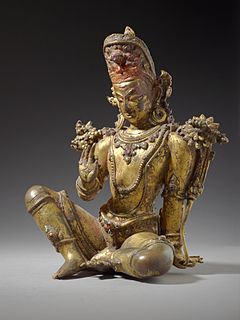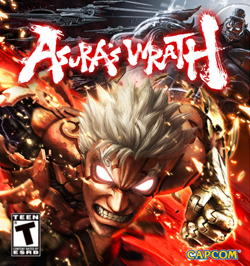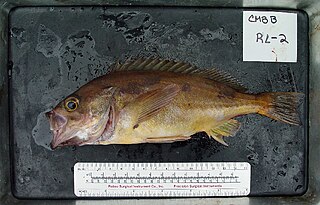
Asuras are a class of divine beings or power-seeking deities related to the more benevolent Devas in Hinduism.

Deva means "heavenly, divine, anything of excellence", and is also one of the terms for a deity in Hinduism. Deva is a masculine term; the feminine equivalent is Devi.

Daeva is an Avestan language term for a particular sort of supernatural entity with disagreeable characteristics. In the Gathas, the oldest texts of the Zoroastrian canon, the daevas are "gods that are rejected". This meaning is – subject to interpretation – perhaps also evident in the Old Persian "daiva inscription" of the 5th century BCE. In the Younger Avesta, the daevas are divinities that promote chaos and disorder. In later tradition and folklore, the dēws are personifications of every imaginable evil.

The samudra manthana is one of the best-known episodes in the Hindu philosophy narrated in the Bhagavata Purana, in the Mahabharata and in the Vishnu Purana. The samudra manthana explains the origin of amrita, the nectar of immortality.
There are 1000 hymns in the Rigveda, most of them dedicated to specific deities.

An asura in Buddhism is a demigod or titan of the Kāmadhātu. They are described as having three heads with three faces each and either four or six arms.
Pelomys is a genus of rodent in the family Muridae endemic to Africa. It contains the following species:
Hopkins's groove-toothed swamp rat is a species of rodent in the family Muridae. It is found in Kenya, Rwanda, Uganda, possibly Burundi, and possibly Tanzania. Its natural habitat is swamps. It is threatened by habitat loss.

Asura is a genus of moths in the subfamily Arctiinae.
Predicrostonyx hopkinsi is an extinct rodent in the family Cricetidae, and is considered one of the earliest examples of collared lemmings.
Proraphidia is a genus of snakefly in the extinct family Mesoraphidiidae. The genus currently contains three species; Proraphidia gomezi from Spain, Proraphidia hopkinsi from England, and the type species Proraphidia turkestanica from Kazakhstan. The genus was first described by O. M. Martynova in 1941 with the publication of P. turkestanica from Jurassic deposits in Karatau, Kazakhstan.
Prahlada was a king, the son of Hiranyakashipu and Kayadhu, and the father of Virochana. He belonged to the Kashyap gotra. He is described as a saintly boy from the Puranas known for his piety and bhakti to Lord Vishnu. Despite the abusive nature of his father, Hiranyakashipu, he continued his devotion towards Lord Vishnu. He is considered to be a mahājana, or great devotee, by followers of Vaishnava traditions and is of special importance to devotees of the avatār Narasiṁha. A treatise is accredited to him in the Bhagavata Purana in which Prahlāda describes the process of loving worship to his Lord Vishnu. The majority of stories in the Puranas are based on the activities of Prahlāda as a young boy, and he is usually depicted as such in paintings and illustrations.

Asura's Wrath is a beat 'em up video game developed by CyberConnect2 and published by Capcom. Asura's Wrath was first announced at the Tokyo Game Show in 2010, and was released worldwide in February 2012.

Paramormyrops hopkinsi (Taverne and Thys van den Audenaerde, 1985) is a species of freshwater electric fish. It was discovered in the Ivindo River in Gabon, in west-Central Africa by Dr. Carl D. Hopkins of Cornell University. It is distributed throughout the Ivindo River basin of Gabon and the Ntem River basin of Cameroon. Described originally as a Brienomyrus in 1985 it was transferred to Paramormyrops in 2007. The electric discharge has two phases: a head-positive phase followed by a head-negative phase. The mean duration of the EOD is 2.8 ms for females, 2.96 for males. The Fourier transform of the EOD peaks at 536 Hz for females, 468 for males. Both male and female EODs have a head-negative voltage bump about 5 to 6 ms after the main head positive phase (arrows).
Asura undulosa is a moth of the family Erebidae. It is found in the north-western Himalayas, Sikkim, Bhutan and Burma.
Asura quadrilineata is a moth of the family Erebidae. It is found on Aru and in Australia.

Sebastes hopkinsi is a species of fish in the rockfish family found in the shallow reefs of the Eastern Pacific

Harrisoniella hopkinsi is a species of phtilopterid louse that lives on and eats the feathers of albatrosses. The species was first described by W. Eichler in 1952.
Synopeas hopkinsi is a species of ants, bees, wasps and sawflies in the family Platygastridae.











